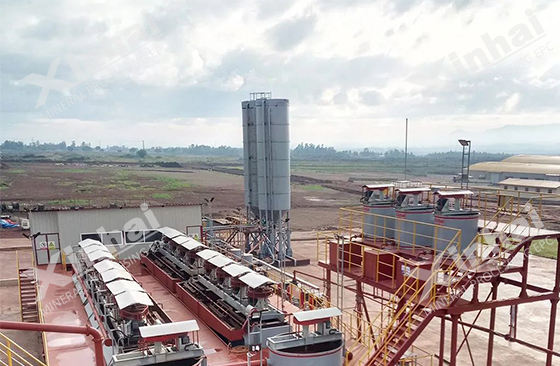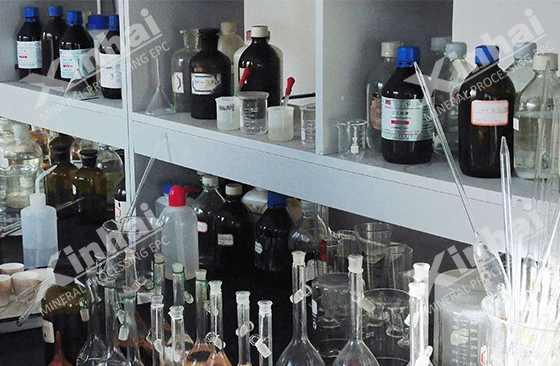In the process of froth flotation and beneficiation, the reagent system includes reagent type, dosage, addition method and location, also known as prescription. During production, whether each flotation plant can obtain satisfactory flotation indexes depends largely on whether the reagent system used is correct. Especially for the flotation plant of polymetallic ore or complex refractory ore, the selection of appropriate reagent system is the most important.
In the production process, different froth flotation principle processes need to adopt different reagent systems. In order to make flotation reagents play an ideal role, we must follow the following three basic principles when determining the reagent system:

First easy then difficult, that is, the minerals that are easy to float are floated out first, and then the minerals that are difficult to float are floated out. In other words, inhibit the minerals with poor floatability or easy to be suppressed, not the minerals with good floatability or difficult to be suppressed.
For example, in lead-zinc sulfide ores, the main useful minerals are galena and sphalerite. The floatability of galena is better than that of sphalerite. It is difficult to inhibit galena, but it is easy to inhibit sphalerite. Therefore, sphalerite flotation out of galena can be inhibited first.
When the floatability of the two minerals is similar, it should be considered that the minerals with less floatation and more inhibition are easy to get better flotation indexes.
For example, in copper lead zinc sulfur polymetallic ores, the main useful minerals are chalcopyrite, galena, sphalerite and pyrite. Among them, chalcopyrite and galena have good floatability. Therefore, these two minerals are often floated out at the same time to obtain a copper lead mixed concentrate, and then the copper lead mixed concentrate is separated (copper flotation or copper flotation).
The floating high and depressing low mentioned here mainly include two situations: one is to float minerals with high value first and suppress minerals with low value. The other is to flotate the minerals with high requirements for concentrate quality first and suppress the minerals with low requirements for concentrate quality.

Flotation the minerals with high value first, and inhibit the minerals with low value. This reagent system is relatively easy to achieve the purpose of flotation and obtain better economic benefits. For example, in the lead zinc iron sulfide ore or copper zinc iron sulfide ore, after the separation of lead or copper, the remaining useful minerals are mainly sphalerite and pyrite. From the perspective of floatability, the floatability of inactive sphalerite is not better than that of pyrite. In practice, most flotation plants will select sphalerite before pyrite. On the one hand, the floatability of activated sphalerite is obviously improved. On the other hand, because the value of sphalerite is higher than that of pyrite, the content of sphalerite in ore is usually lower than that of iron sulfide.
Flotation of minerals with high requirements for concentrate quality and suppression of minerals with low requirements for concentrate quality. This reagent system is often applicable to ore dressing with high requirements for concentrate quality. For example, in the flotation process of molybdenum bearing chalcopyrite ore, since both molybdenite and chalcopyrite have good floatability, the copper molybdenum mixed concentrate can be obtained first, and then the copper molybdenum mixed concentrate can be separated again. In the separation process of copper molybdenum mixed concentrate, most flotation plants will adopt the flotation scheme of copper suppression and molybdenum flotation. Besides that the value of molybdenum is higher than that of copper and the grade of molybdenum is lower than that of copper, the higher quality requirement of molybdenum concentrate is also an important reason. If the flotation scheme of inhibiting molybdenum and floating copper is adopted in turn, all gangue contained in the copper molybdenum mixed concentrate will enter the molybdenum concentrate, making the quality of molybdenum concentrate difficult to meet the requirements.
For flotation plants, the reagent system is usually determined by ore washability test or semi industrial test, and the type, dosage, adding location, sequence and mode of reagent used are not allowed to be changed easily in production operation. Therefore, it is recommended to conduct beneficiation test in advance, make specific analysis on ore properties and possible flotation treatment schemes, and select reagent systems suitable for the actual situation of the flotation plant one by one according to different flotation cycles after determining the flotation principle flow.